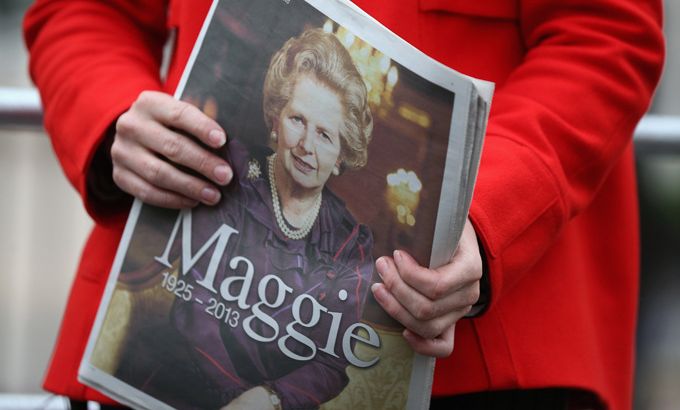
Margaret Thatcher’s final call
Media coverage of the death of the former British leader has mirrored the divisions which marked her political life.
‘As divisive in death as she was in office’ is a phrase that has frequently been repeated in the British media since former Prime Minister Margaret Thatcher’s death on April 8. And nowhere was that more true than in their own coverage.
Depending on where Britons get their news, Thatcher was either an ‘Iron Lady’ who rescued the UK and modernised its economy, or an elitist who looked down at the working classes and crippled British industry.
Keep reading
list of 4 itemsInside the pressures facing Quebec’s billion-dollar maple syrup industry
‘Accepted in both [worlds]’: Indonesia’s Chinese Muslims prepare for Eid
Photos: Mexico, US, Canada mesmerised by rare total solar eclipse
Britain’s right-leaning press, many of which are owned by key Thatcher ally Rupert Murdoch, stood in her favour while the liberal press seized on the opportunity to criticise her policies and blame her for some of Britain’s current problems.
It is said that one should not speak ill of the dead. But that did not stop liberal papers from passing harsh judgment on a prime minister whose policies, they say, have not grown better with time.
It was inevitable then, fitting even, that Thatcher’s death would prove to be as polarising an event as her 11 years in office. It gave Britain’s opinionated press one last chance to argue over her record, her place in history, and the way she was eulogised, at a ceremony that looked suspiciously like the state funeral that the Cameron government insisted it was not.
To discuss the media legacy of Margaret Thatcher we are joined by: the Guardian’s Simon Jenkins; Peter Oborne from the Daily Telegraph; journalist Maggie Brown; and James Curran, a professor of communications at London’s Goldsmith’s University.
Vice: News for the ‘cool’ kids
Back in February, North Korea’s hermetic leader Kim Jong-un was pictured hanging out with a former US sports star, Dennis Rodman, in the North Korean capital Pyongyang. It was the first time an American had met the Supreme Leader and the story topped news agendas around the world.
The company behind the stunt was a New York-based media outlet called Vice. The stunt was typical of Vice’s style. Since launching in the 1990s, the outlet has become known for its off-beat, sometimes outrageous take on current affairs. While some media commentators say its style of journalism has brought current affairs to a demographic largely ignored by the mainstream media, others slam it off for being offensive and say it is more concerned with entertaining and shocking its audience than producing serious journalism.
The Listening Post’s Meenakshi Ravi speaks with Shane Smith, Suroosh Alvi and Jason Mojica from Vice; New Yorker journalist Lizzie Widdicombe; Joe Pompeo from Capital New York; and Jacobin magazine editor Bhaskar Sunkara.
On this week’s Newsbytes: Gunmen storm the premises of a critical Tamil newspaper; the murder of a Brazilian photographer takes the number of journalists killed in the country this year to 13; and the Washington Post puts its iconic office up for sale.
And we end the programme this week with a trip around the world. The Listening Post team could not choose between two videos for the section so we decided to put the two together and run it as one!
The first one was a Google Street View Hyperlapse that takes pictures of endless streets and turns them into something special. The other is a time-lapse footage of Earth from the International Space Station which contains some stunning shots. Our home made Web Video of the Week has a combined 6.5 million hits.
Listening Post can be seen each week at the following times GMT: Saturday: 0830, 1930; Sunday: 1430; Monday: 0430. Click here for more Listening Post. |
